Creating a credible dossier
What follows is not meant to be a blueprint for a ‘good dossier’, but merely a first approach presenting some examples illustrating questions of methodology, the comparative study, the global survey of a period, and so on. The demonstration of Outstanding Universal Value (OUV) is a crucial objective of the dossier, and the value of the property can really only be demonstrated in relation to the global cultural and historical context. (N.B. In some cases the comparisons need not be global but can be within a geo-cultural region.) For general issues dealing with the preparation of a dossier see Preparing a nomination dossier.
A ‘bad dossier’ will lead to misunderstandings and certainly fail to demonstrate OUV. Typical shortcomings in existing dossiers suggest that the main failings might be:
- weaknesses in defining the property, demonstrating the importance of the astronomical evidence, and/or showing how the astronomical significance is conveyed by the material evidence;
- weakness in the comparative study (inadequate comparisons with other potential sites);
- a flagrant overestimation of the local or regional significance of the property’s attributes and/or the overemphasis of particular functions;
- an insufficient understanding of the cultural–historical context, and/or overly superficial historical studies; and
- overly controversial interpretation of the site, artefacts, etc.
Definition of the property, inventory, and definition of the buffer zone
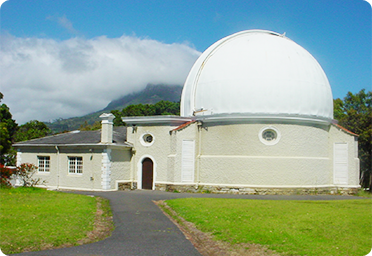
The McClean building, Royal Observatory, Cape of Good Hope, South Africa. Photograph © Ian Glass
Strictly speaking, ‘movable’ objects as opposed to ‘immovable’ heritage are not covered by the Convention. However they may well form an integral part of a ‘monument of science’. Examples not only include observatories containing moving instruments such as modern telescopes; the observatory itself may have fixed walls but a moving dome or rising floor, as for example the McClean Building at the Royal Observatory, Cape of Good Hope, South Africa, or may have both fixed and movable instruments integral to the design, as in the case of a radio-astronomy interferometer comprising a fixed dish and one or more that are movable, for example along rails. This parallels a known situation with regard to technology heritage already inscribed on the World Heritage List, examples being the Semmering Railway, Austria, the three Indian mountain railways, and the Albula-Bernina railway across the Swiss Alps. In all these cases the line itself (track and infrastructure) together with the stations have been recognised as of Outstanding Universal Value but the inscription does not include the rolling stock, because it is movable. On the other hand, movable parts of ‘machines’ inscribed on the World Heritage List are entirely part of the property, examples being the Transporter Bridge of Vizcaya (Spain), the locks in the Canal du Midi (France) and Rideau Canal (Canada) and the hydraulic lifts of the Canal du Centre (Belgium). Here, ‘immovable’ and ‘movable’ must be understood in their classic juridical sense.
From a science or technology heritage point of view, then, it is clearly essential to extend the inventory to include movable portions where they form an integral part of the ‘monument of science’. It is perhaps necessary to reemphasize that these parts perform actions, need to be maintained, and need to be replaced from time to time. Such an approach has already proved productive in technology heritage.
The example of space heritage clearly shows that there exist certain types of astronomical endeavour for which it is impossible to recognise science heritage sites on the list: only technology heritage sites. In many other cases, the heritage of the science is inseparable from the heritage of the technology, and it is natural to deal with both together in the application of the Convention.
Where features in the natural landscape form an integral part of alignments preserved in architecture, the most productive approach may be to consider two different concepts: cultural landscape heritage that should be included as part of the property, and landscape preservation that forms part of the protection of the setting. The existence of such alignments, and hence the desirability of maintaining the visible landscape in certain directions, could certainly influence the definition of a buffer zone. The definition of the setting is also of critical importance at dark-sky sites, where one needs to ensure the maintenance of the dark sky in the core area (see ‘Windows to the universe’).
Serial nominations
Serial nominations relate to groups of discrete sites that demonstrate outstanding universal value as a group. Within astronomical heritage sites this can arise in three distinct ways:
- where the group represents the material heritage relating to a single, integrated concept;
- where the sites in the group are linked thematically; and
- where the evidence of universal value can only be obtained by considering the group as a whole.
The 34 nodes of the Struve geodetic arc clearly form a group of the first type. The arc itself is a single, integrated concept. The Iberian seven-stone antas form a group of the third type. Each of the antas in the group was evidently built according to strict prevailing protocols, but we need the group as a whole in order to recognise the existence of a specific practice of astronomical orientation and hence to appreciate its significance and demonstrate its value. In this case, the definition of the property also deals clearly with the integrity concept.
A thematically linked group could relate, for example, to architectural typology, types of instrument, types of science or the nature of discoveries. Thematic linkage perhaps holds the widest potential but it also presents the greatest challenges in creating a consistent and valuable (in the sense of OUV) group while avoiding producing what is essentially no more than a catalogue of sites. To take just one example, Strasbourg Cathedral in France—which provides another starting point for reflection about astronomical heritage within existing World Heritage Sites—introduces a broader thematic context (medieval astronomical clocks) that might conceivably form the basis of a serial heritage approach, drawing out important new types of value. For this to be successful, though, each member of the group (each clock) would have to contribute effectively and significantly to OUV.
Whether OUV is best demonstrated for any particular theme through a single nomination or a serial nomination, where both possibilities are viable from the scientific point of view, requires careful consideration. Serial nomination may be more globally representative of a particular development or concept, but each element of the series must bear a significant part of the OUV by itself and so the ‘weakest link’ might bring it down. On the other hand, a single nomination may ‘cast a shadow’ on other future nominations, since its acceptance (through a comparative analysis) would imply that the one site concerned adequately characterises the OUV of the development or concept in question, and so the others are not needed.
Compromises may be possible. Serial nomination is not the only way of making connections between different sites: other options include twinning and networking between sites already on the List, on the basis of informal agreement. This has proved a successful approach in the case of Biosphere Reserves, linked through UNESCO’s Man and the Biosphere Programme.
Credibility as an authenticity issue
The various thematic essays and case studies (see the astronomical heritage finder) raise a range of matters relating to authenticity and integrity and serve to demonstrate the complexity of the issues involved. To take just one example, the circular Zodiac, the most significant astronomical artefact in the Temple of Hathor at Dandara, Egypt was removed to the Louvre in Paris, where it is well preserved, and its exact original position is marked by a good-quality replica. The issues of scientific information in context, materiality of the evidence, and position of the evidence, would all be relevant to the question of authenticity in this case.
The authenticity of a ‘fact’ is linked to its credibility, as judged by current standards in the relevant academic discipline. The issue of credibility is especially critical where the basic evidence comes from archaeoastronomy, a relatively new and in itself strongly interdisciplinary field of endeavour, where issues of theory and method are still hotly debated. Before accepting the intentionality and putative meaning(s) of astronomical alignments at archaeological, and particularly prehistoric, sites—however self-evident they might appear to the modern eye, or however stunning the associated visual hierophany—it is essential to consider the broader cultural context, balanced where possible with appropriate statistical confirmation. The thematic essays on later prehistoric Europe and pre-Columbian America, and several of the case studies relevant to them, illustrate this point in different ways.
Nowhere are the difficulties clearer than in the oldest evidence of all, relating to earlier prehistory. Evidence of this type is complex. It is also inherently subjective—there are many stars in the sky and many drawings upon which one might seek to impose an astronomical interpretation—so evidence of this type and has to be weighed up with great care as well as paying sufficient attention to the cultural context.
It is helpful to identify four broad categories of archaeoastronomical credibility, examples of each of which can be found at existing World Heritage sites:
Generally accepted
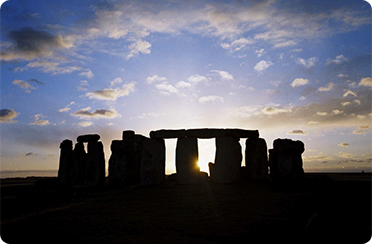
Midwinter sunset at Stonehenge, United Kingdom. Photograph by James O. Davies, © English Heritage (Photo Library N030018)
Examples: the alignment of the Neolithic passage grave at Newgrange in Ireland upon the rising sun at midwinter, and the solstitial alignment of Stonehenge in the United Kingdom. While the intentionality of these alignments is largely undisputed, the interpretation of their purpose(s) and meaning(s) continues to be debated.
Debated among specialists
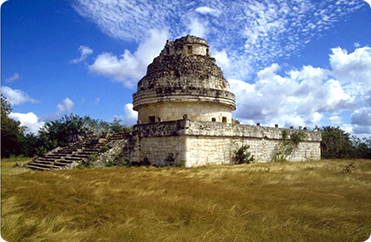
El Caracol, Chichen Itza, Mexico. Photograph © Clive Ruggles
Example: the interpretation of the circular Caracol at Chichen Itza in Mexico as an observatory for watching the risings and settings of the sun, planets and stars. Archaeoastronomers continue to debate this interpretation. Despite the uncertainties, the building is widely referred to as ‘the Observatory’.
Unproven
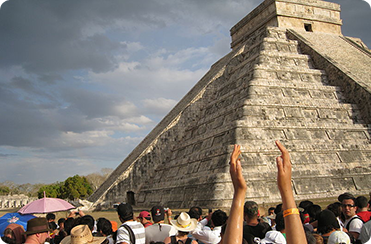
Equinox hierophany’ at the Kukulcan pyramid, Chichen Itza, Mexico. Photograph by Bmamlin, authorised by Wikimedia Commons
Example: the ‘equinox hierophany’ at the Kukulcan pyramid, again at Chichen Itza. This phenomenon attracts many thousands of visitors each year, but there is no convincing historical or contextual evidence to support the conjecture that it was actually deliberate and intentional. Despite this, it is widely cited as the principal astronomical connection of the site.
Refuted
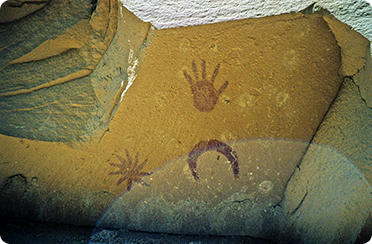
So-called supernova pictograph, Chaco Canyon, New Mexico, USA. hotograph © Clive Ruggles
Example: the interpretation of four rock-painted symbols at Chaco Canyon, USA as a depiction of the 1054 supernova. Cultural evidence strongly suggests that the symbols marked a sun-watching station for native priests. Yet the ‘supernova’ interpretation remains widely quoted.
It is not unusual for the number of serious scholarly archaeoastronomical interpretations to be relatively small while the number of highly speculative interpretations available, both in popular publications and on the internet, is much larger—the pyramids of Giza in Egypt are a good example. This not only has a serious affect upon public perceptions, but can also start to affect ‘official’ perceptions, as has occurred for example at Chichen Itza, where the Management Plan is reportedly being revised to take account of the equinox hierophany at Kukulcan.
Another factor that can sway public, and even official, opinion is the perception of certain ancient sites as demonstrating the intellectual achievements of ancestors and hence feeding modern nationalist agendas. A notorious example is the stone circles at Odry, Poland, used for Nazi propaganda during the 1930s. A sense of national pride or political expediency can sometimes be implicit in claims that, for example, a site is ‘the oldest observatory’ in a given region. The irony is that such attitudes are founded upon a mistaken belief in a single ‘path of progress’ towards modern science, something that actually places a negative value on other cultural perspectives and practices.
It may well be that a global programme should be developed with a view to helping State Parties identify those archaeological, and particularly prehistoric, sites that might be most credible as nominations to the World Heritage List on the basis of the archaeoastronomical evidence of their association with astronomy.
Management: general considerations
Measures for the protection, conservation and management of properties nominated to the World Heritage List need to be set out in the nomination dossier. They should be presented as an overall management system, and may be set out in the form of a Management Plan for the property, put into practice with the engagement of stakeholders and the approval of the State Party who will need to respect and apply it. The Operational Guidelines give a range of advice on this matter (items 96–98, 108–119 and 132–135; see also items 99–102 [the property] and items 103–107 [the buffer zone]). [‘Protection’ involves national, regional and local laws and planning regulations. A relevant and efficient juridical system must be presented to protect the property against all types of threat to the attributes that contribute to its outstanding universal value, both in the property itself, in its setting, and in relation to particular environmental issues that could affect its scientific function. The central idea is to maintain the integrity and authenticity of the property for the present and for the future—to sustain its OUV.
The overall management should rely upon professional competence in a range of different fields, such as architecture, construction, urbanism, archaeology and history, or whatever is relevant for the property.
The various aspects of protection and conservation should each be combined with the other aspects of property management—such as tourism organisation and facilities, and education, interpretation and outreach—with regard not only to the property itself, but also covering neighbour relationships, etc. For management to be effective, there must be sufficient and guaranteed funds to support the overall process.
It is worth emphasizing that for an astronomical heritage property the various general components of the dossier should be formulated in exactly the same way as they are for all other properties, with the same professionalism in addressing the different aspects of juridical protection of the property and its setting, and in the management system. The specificities of astronomical heritage management must be included in the management system as a separate topic, fully coordinated with the general issues and addressing, for example, the conditions for careful use and maintenance of the astronomical instruments, the availability of advice from astronomers the need for controlled scientific interpretations, and programmes of scientific education linked to the particular significance of the property.
Return to “Initial considerations”
Return to “Evaluating an astronomical heritage site”
Return to “Preparing a nomination dossier”
The contents of this page are based upon text in the ICOMOS-IAU Thematic Study no. 1 (2010). Original text © Clive Ruggles, Michel Cotte and the contributing authors.

